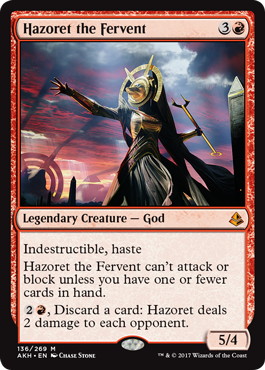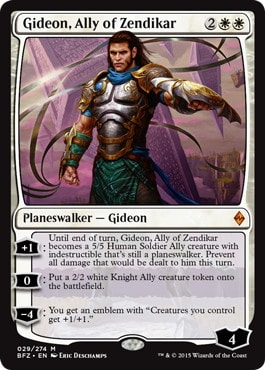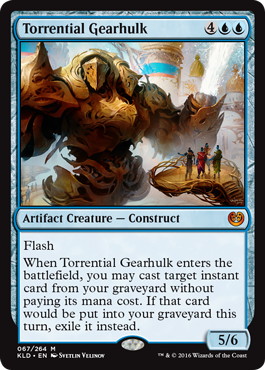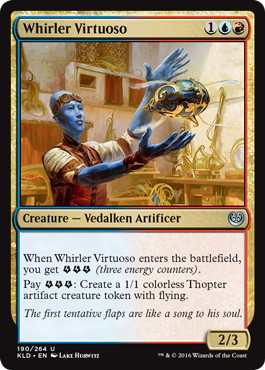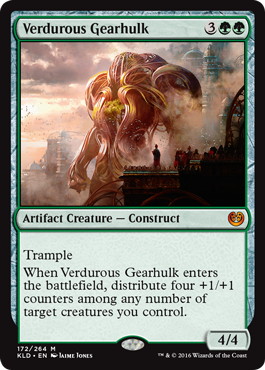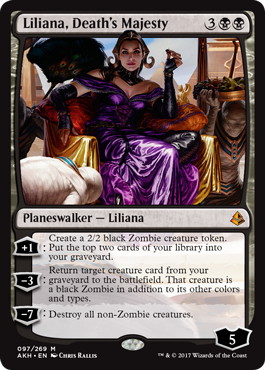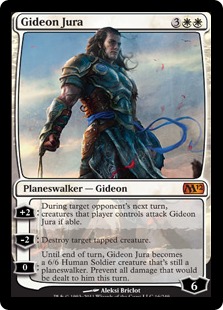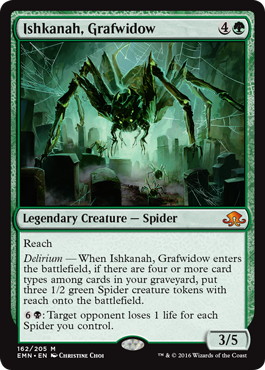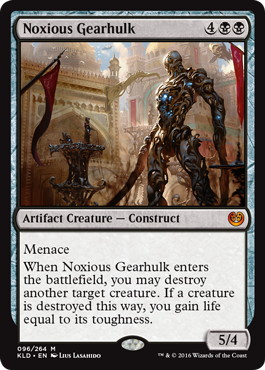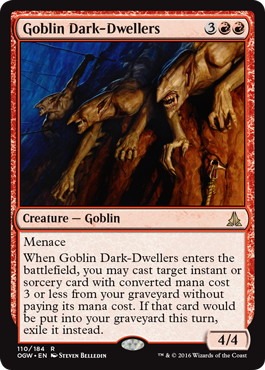Spoiler season started last week with Amonkhet, and it is looking good. Based on the limited number of cards released so far, it looks like a pretty slow set (cycling, embalm etc.) – which I love for limited, since it makes the game less dependent on your opening hand – and the power level is decently high, if you are ready to work for it.
What I mean here is that a lot of cards could be strong enough to have a significant impact on Standard, but you will not be able to just jam them in any deck. I love those kind of build-around cards, and that is what I want to focus on in this article.
《Hazoret the Fervent》
This is a card with huge upsides, and one enormous downside to work through. Let us start with “How good are the upsides?”.
Would we even play 《Hazoret the Fervent》 if he did not have the “almost hellbent” clause? I know that might sound silly, but in a world where the 4-drops are as strong as 《Gideon, Ally of Zendikar》and 《Chandra, Torch of Defiance》, I think it is worth giving it a little bit of a thought. First, despite the indestructible clause, 《Hazoret the Fervent》 still dies to 《Grasp of Darkness》and the newly printed 《Cast Out》 without generating any value.
He also lacks trample, meaning that he will not be quite as effective as you’d hope against 《Gideon, Ally of Zendikar》 himself (even though he might take him out, but at the insane cost of 2 cards and 6 mana), but is still a very efficient solution to 《Chandra, Torch of Defiance》 and planeswalkers in general. Now, if 《Hazoret the Fervent》 survives (which I suspect he still will in most situations), he is likely to always be the absolute best creature on board and should force a chump block each turn…unless he faces either a 《Torrential Gearhulk》, a 《Verdurous Gearhulk》, or even a 《Whirler Virtuoso》 that will keep him at bay at the cost of 3 energy per turn.
See where I am going? Even before going into the downsides, I am afraid that 《Hazoret the Fervent》 is joining a Standard format that is already very well prepared to deal with him.
Still, if it was not for its downside, 《Hazoret the Fervent》 is a very pushed 4-drop that you would play over anything other than 《Gideon, Ally of Zendikar》 if you want to be aggressive. In black-red aggro, for example, he would certainly be a better 4-drop than 《Chandra, Torch of Defiance》. But how big is the downside? Here, the easiest comparison would be with 《Lupine Prototype》, which basically never saw any constructed play at all.
But I think this is a misleading thought, for three reasons:
All in all, I think that if you play a deck that naturally wants a 5/4 haste beater at four mana, it will take very little to make it work, and you will be able to use 《Hazoret the Fervent》 with very high consistency and very little pressure to change how you play your cards.
Summing things up: I think 《Hazoret the Fervent》 is not quite as “insanely powerful” as his raw stats make him look, but I also think he is much, much easier to use than most people think. Instead of thinking of him as a huge risk / huge rewards card, you should think of him as a pretty strong top curve for aggressive red decks that cannot play 《Gideon, Ally of Zendikar》.
Here is, I think, a decent example of a deck using 《Hazoret the Fervent》 to its full potential:
|
7 《Swamp》 6 《Mountain》 4 《Smoldering Marsh》 4 《Foreboding Ruins》 2 《Spire of Industry》 -Lands (23)- 4 《Inventor's Apprentice》 4 《Bomat Courier》 4 《Forerunner of Slaughter》 4 《Scrapheap Scrounger》 2 《Olivia, Mobilized for War》 1 《Pia Nalaar》 2 《Weldfast Engineer》 2 《Hazoret the Fervent》 -Creatures (23)- |
2 《Fiery Temper》 2 《Shock》 4 《Unlicensed Disintegration》 4 《Heart of Kiran》 2 《Key to the City》 -Spells (14)- |

This is a pretty straightforward aggro deck, that also uses 《Key to the City》 and 《Hazoret the Fervent》 to enable a little bit of a madness subtheme and makes sure you always have a ton of reach. It is typically a deck where you will always be able to use 《Hazoret the Fervent》 to its full potential, while not really making any sacrifices at all, and in the unlikely event of 《Gideon, Ally of Zendikar》 being banned, this would be my frontrunner for “best week 1 aggro deck” in Standard.
Note that I did NOT try to build the deck with both 《Lupine Prototype》 and 《Hazoret the Fervent》, even though both cards seem to be pushing in the same direction. The thing is, I think that they actually are not.
If you play 《Lupine Prototype》, you absolutely do not want a four-drop in your deck because you will obviously have it in your hand on turn 3 and it also forces you to run a little bit more lands than you would like, meaning that you will sometimes draw a land when you still have one in hand and not be able to do anything with your prototype. I suspect this is a deckbuilding trap that some players might fall for, so, fair warning: do not fall for this.
《Liliana, Death’s Majesty》
A good planeswalkers is a planeswalker that can defend itself if played on an empty board. Usually, they do it either through a defensive ability (Chandra’s -3, Nissa’s +1…), or simply thanks to a huge amount of loyalty counters like good old《Gideon Jura》.
Well, she does both. Which is what got me so excited about the card in the first place. See, when you see a reanimate effect (like her -3) , it is easy to think about all the ugly monsters you might bring back. We will discuss it of course, but to me, the main appeal of the card is the combination of her +1 and her -7. If played on a board that is favourable or about equal, she is incredibly likely to win the game by simply forcing disastrous attacks from your opponent facing the grim perspective of a one-sided 《Wrath of God》.
There are basically 2 easy ways to build around 《Liliana, Death’s Majesty》. The first one is to use her as a win condition in a grindy Black-green or Black-white deck. Black-green is the most obvious, because her +1 happens to be a great enabler for Delirium and because you will naturally play decent targets to reanimate, like 《Ishkanah, Grafwidow》,and 《Noxious Gearhulk》. As it is, this might be the answer to the problem of “what do you win with after you cast《Ishkanah, Grafwidow》” that we have been facing ever since 《Emrakul, the Promised End》 left Standard.
I like this option a lot, and that would certainly be the first thing to try on my list.
|
6 《Swamp》 4 《Forest》 4 《Evolving Wilds》 4 《Blooming Marsh》 2 《Hissing Quagmire》 -Lands (20)- 4 《Grim Flayer》 4 《Tireless Tracker》 3 《Gonti, Lord of Luxury》 3 《Ishkanah, Grafwidow》 2 《Noxious Gearhulk》 -Creatures (17)- |
4 《Fatal Push》 4 《Traverse the Ulvenwald》 2 《Grasp of Darkness》 2 《Grapple with the Past》 3 《Ruinous Path》 4 《Renegade Map》 2 《Liliana, the Last Hope》 2 《Liliana, Death’s Majesty》 -Spells (23)- |

The other option is, of course, to abuse the reanimate effect and try to cheat the most ridiculous creatures into play. Problem is, there are not too many stupid creatures to reanimate, so you are stuck with 《Ulamog, the Ceaseless Hunger》and 《Void Winnower》. Both are very decent, but I suspect that if cheating big monsters into play is your thing,《Aetherworks Marvel》remains a better way to do that. In all fairness, I would much rather be reanimating creatures that I can also just cast normally, such as 《Goblin Dark-Dwellers》 for example.
Obviously, those two are just some of the cards that I am excited about: 《As Foretold》 could be worth having its own article, if only for the combination with 《Ancestral Vision》 and many other similar cards are worth exploring. But those are thoughts for another day.
Until next time.
Pierre Dagen
Recommended Items
Share in Twitter
Share in Facebook



